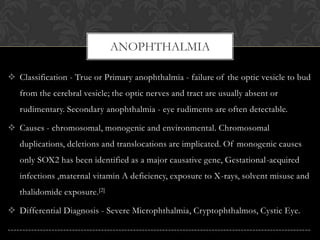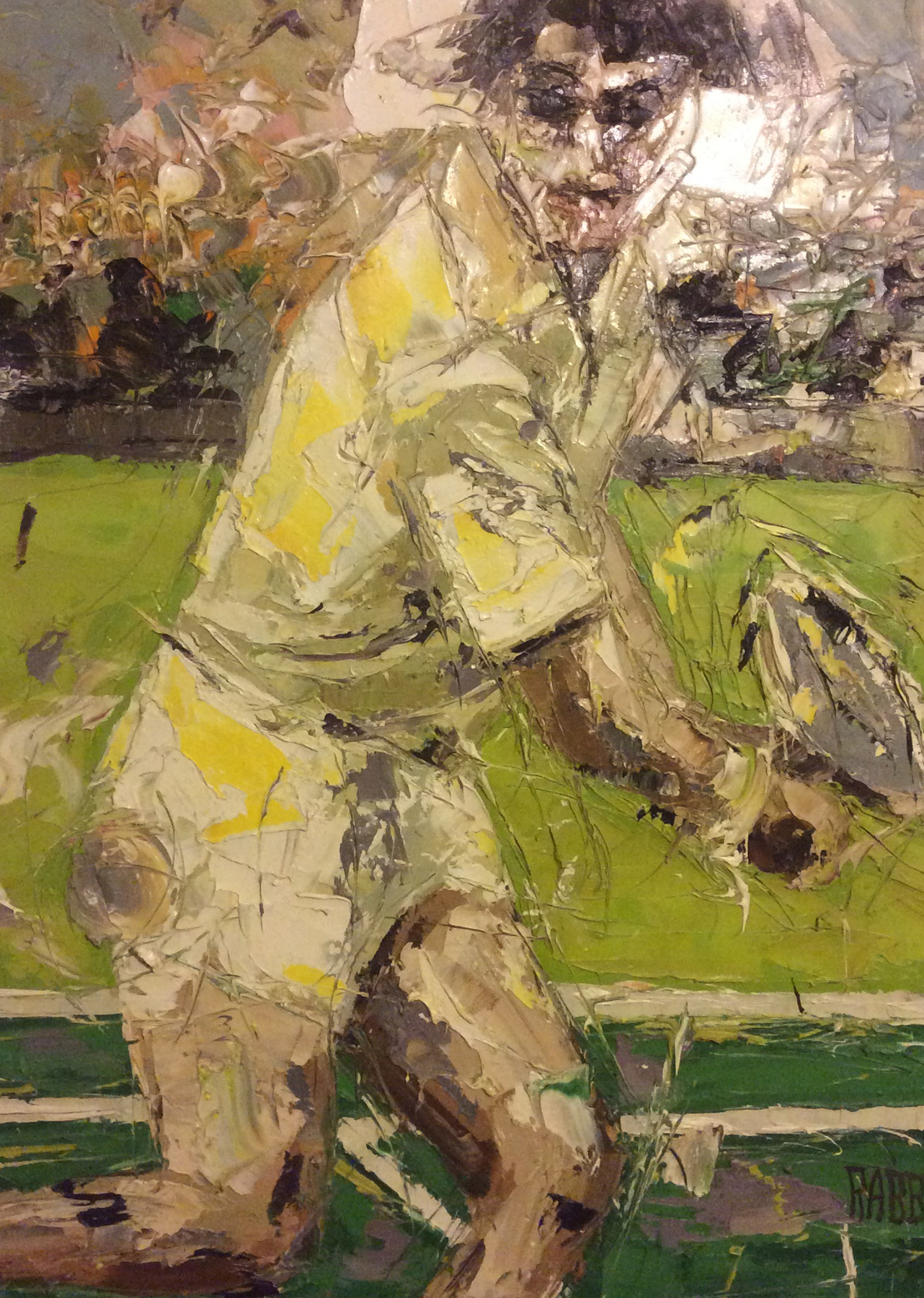Bilateral Anophthalmia In Infants: Diagnosis, Treatment, And Support

Table of Contents
Understanding Bilateral Anophthalmia
Causes and Genetics
The exact cause of bilateral anophthalmia remains elusive in many cases, making early identification of contributing factors crucial. While some cases are linked to specific genetic syndromes, others may result from a complex interplay of genetic and environmental influences. Genetic testing can sometimes identify specific gene mutations associated with anophthalmia, providing valuable information for families, including recurrence risks.
- Potential genetic syndromes linked to anophthalmia: Several genetic disorders, including anophthalmia-microphthalmia syndrome, CHARGE syndrome, and Walker-Warburg syndrome, are associated with the absence of one or both eyes.
- Role of teratogens: Exposure to certain medications, infections, or environmental toxins during pregnancy can potentially disrupt fetal development, leading to conditions like bilateral anophthalmia.
- Complexity of causation: It's vital to understand that the exact cause of bilateral anophthalmia isn't always definitively determined. Research continues to explore the genetic and environmental factors involved.
Prenatal Diagnosis
Early detection of bilateral anophthalmia during pregnancy can provide parents with time to prepare and access crucial support services. Prenatal ultrasound scans, typically performed between 18 and 22 weeks of gestation, can often reveal the absence of fetal eyeballs. Other prenatal screening methods, while not specifically detecting anophthalmia, may provide clues regarding potential fetal abnormalities.
- Typical timeframe for prenatal diagnosis: Most cases of bilateral anophthalmia are diagnosed prenatally through ultrasound, typically during the second trimester.
- Accuracy of diagnostic techniques: Ultrasound is the primary method for prenatal diagnosis, offering reasonable accuracy in detecting the absence of eyeballs. However, further assessment is usually recommended after birth.
- Emotional implications of prenatal diagnosis: Receiving a prenatal diagnosis can be emotionally challenging. Access to genetic counseling and support groups is crucial for parents during this difficult time.
Postnatal Diagnosis and Confirmation
Following birth, a thorough clinical examination by an ophthalmologist confirms the diagnosis of bilateral anophthalmia. This assessment involves a careful evaluation of the eye sockets, surrounding tissues, and overall facial structure. Early and accurate diagnosis is critical for planning appropriate interventions.
- Examinations conducted: Ophthalmologists use specialized tools and techniques to examine the infant's eye sockets. Other specialists, such as geneticists and craniofacial surgeons, may also be involved.
- Importance of communication: Open, honest, and compassionate communication with parents is paramount. Explaining the diagnosis, treatment options, and available support systems is crucial for alleviating anxieties and fostering hope.
Treatment Options for Bilateral Anophthalmia
Prosthetic Eyes (Ocular Prostheses)
Prosthetic eyes, or ocular prostheses, are custom-made artificial eyes designed to restore a natural appearance. Early fitting is crucial for optimal cosmetic and psychological outcomes, minimizing the impact of missing eyes on facial development and self-esteem.
- Materials and manufacturing: Prosthetic eyes are typically crafted from materials like acrylic or glass, carefully matched to the individual’s eye color and skin tone. The creation process involves detailed measurements and custom molding.
- Fitting and adjustments: Regular follow-up appointments are needed to ensure proper fit and adjustments as the child grows. The prosthetic eye needs to be periodically replaced as the child develops.
- Psychological benefits: Early fitting of prosthetic eyes significantly contributes to a child's emotional and social development, promoting a positive self-image.
Orbital Implants
Orbital implants may be necessary to maintain the shape and volume of the eye sockets. These implants provide a foundation for prosthetic eye fitting and help prevent the sockets from collapsing. They are surgically placed and can be made of various biocompatible materials.
- Types of orbital implants: Different materials are used, including hydroxyapatite, porous polyethylene, and medical-grade silicone. The choice depends on individual factors and surgeon preference.
- Surgical procedure: The implantation procedure is typically performed under general anesthesia and requires careful planning and surgical expertise.
- Risks and complications: While generally safe, orbital implant surgery carries potential risks such as infection, extrusion, and displacement.
Sensory Integration and Development
Despite the absence of sight, sensory integration therapies can stimulate other senses, promoting overall development and cognitive function. Early intervention is key in helping the child adapt and thrive.
- Therapy options: Occupational therapy focuses on developing fine motor skills, sensory processing, and adaptive strategies. Sensory play activities can be used to stimulate tactile, auditory, and olfactory senses.
- Alternative sensory stimulation: Focusing on other senses (hearing, touch, smell, taste) can enhance a child's understanding of the world and encourage cognitive development.
- Promoting independence: A comprehensive therapeutic approach helps develop independence and coping mechanisms that are essential for a fulfilling life.
Support and Resources for Families
Emotional and Psychological Support
The diagnosis of bilateral anophthalmia can be incredibly challenging for parents. Access to emotional and psychological support is critical for navigating the complex emotions and adjusting to the child’s needs.
- Support groups: Connecting with other families facing similar experiences provides valuable emotional support and practical advice.
- Counseling services: Therapy can help parents process their feelings, develop coping mechanisms, and provide strategies for supporting their child's emotional development.
- Parenting resources: Specialized resources and educational materials can offer guidance on specific challenges related to raising a child with bilateral anophthalmia.
Educational and Developmental Support
Early intervention is crucial in addressing the educational needs of children with bilateral anophthalmia. Specialized educational services and assistive technologies are vital for maximizing their learning potential.
- Early intervention programs: These programs provide individualized support, focusing on sensory stimulation, cognitive development, and social skills.
- Specialized education services: Children with bilateral anophthalmia often benefit from individualized education programs (IEPs) tailored to their specific needs.
- Assistive technology: Adaptive technologies can enhance learning and independence, such as braille literacy, screen readers, and assistive listening devices.
Financial Assistance
The medical expenses associated with managing bilateral anophthalmia can be substantial. Families should explore available financial resources to alleviate the financial burden.
- Insurance coverage: It’s crucial to understand your health insurance policy and coverage for prosthetic eyes, surgeries, and related therapies.
- Charitable organizations: Numerous charitable organizations provide financial assistance for families facing significant medical expenses.
- Government programs: Depending on your location, government programs may offer financial support for children with disabilities.
Conclusion
Bilateral anophthalmia presents unique challenges, but with early diagnosis, appropriate treatment, and access to comprehensive support, children can thrive and lead fulfilling lives. Early intervention, encompassing prosthetic eye fitting, orbital implants, and sensory integration therapies, plays a critical role in maximizing developmental outcomes and promoting a positive self-image. Access to emotional, psychological, educational, and financial support is also vital. If you suspect bilateral anophthalmia in your infant or have questions about this condition, seek immediate professional medical advice. Further research into bilateral anophthalmia treatment, support groups, and resources is encouraged to help families effectively manage this condition and provide their children with the best possible quality of life. Remember, hope and a fulfilling future are possible despite the challenges posed by bilateral anophthalmia.

Featured Posts
-
 Nba Playoffs Plires Programma Agonon And Analyseis
May 12, 2025
Nba Playoffs Plires Programma Agonon And Analyseis
May 12, 2025 -
 Gerard Hernandez Et Chantal Ladesou Une Collaboration Sans Filtre
May 12, 2025
Gerard Hernandez Et Chantal Ladesou Une Collaboration Sans Filtre
May 12, 2025 -
 The Rise Of Manon Fiorot A Contenders Story
May 12, 2025
The Rise Of Manon Fiorot A Contenders Story
May 12, 2025 -
 Trump Team Targets Tariff Cuts And Rare Earth Access In China Trade Talks
May 12, 2025
Trump Team Targets Tariff Cuts And Rare Earth Access In China Trade Talks
May 12, 2025 -
 The Netflix Film That Started Adam Sandlers Family Tradition
May 12, 2025
The Netflix Film That Started Adam Sandlers Family Tradition
May 12, 2025
Latest Posts
-
 Sylvester Stallone And Coming Home A Missed Oscar Opportunity
May 12, 2025
Sylvester Stallone And Coming Home A Missed Oscar Opportunity
May 12, 2025 -
 Kojak Itv 4 Schedule When And Where To Watch
May 12, 2025
Kojak Itv 4 Schedule When And Where To Watch
May 12, 2025 -
 Exposition D Art Post Rencontre Avec Sylvester Stallone
May 12, 2025
Exposition D Art Post Rencontre Avec Sylvester Stallone
May 12, 2025 -
 Une Rencontre Inattendue L Histoire De La Visite De Stallone A L Atelier D Une Artiste
May 12, 2025
Une Rencontre Inattendue L Histoire De La Visite De Stallone A L Atelier D Une Artiste
May 12, 2025 -
 Rencontre Exceptionnelle Sylvester Stallone Et L Artiste De Renommee Mondiale
May 12, 2025
Rencontre Exceptionnelle Sylvester Stallone Et L Artiste De Renommee Mondiale
May 12, 2025
